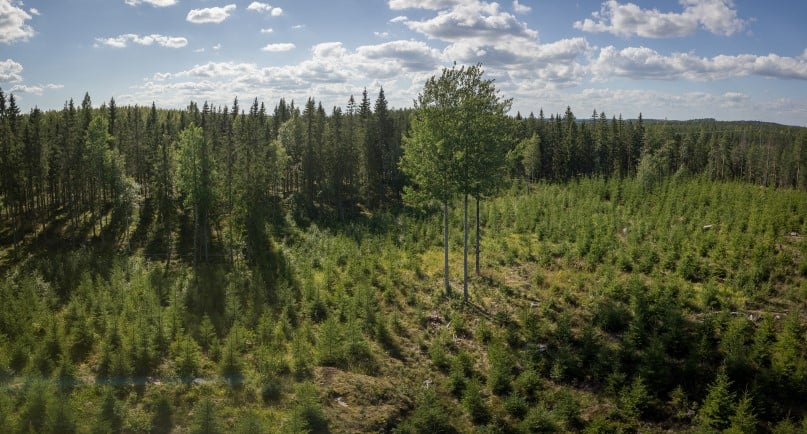In commercial forests, biodiversity is promoted by preserving and adding structural features important for biodiversity. These include large old trees, decaying wood and deciduous trees. One way to add structural features like these is to leave retention tree groups on all felling sites. Retention trees are left in the forest permanently and are not supposed to be removed at any stage. The forest certification criteria also call for retention trees.
Over time, retention trees develop into old trees. When they die, they produce decaying wood throughout the forest’s rotation period. Were the whole stand to be cleared of trees in regeneration felling, with no retention trees left, there would not be enough time for old trees or sturdy decaying wood to be formed during the rotation period.
Dead trees are home to roughly a quarter of all forest species. Saving living retention trees and dead wood is a good way to prevent forest species becoming endangered.
The practice of retention trees emerged in the 1990s. At first, they were left here and there on the felling site, but the current practice is to form groups of retention trees where possible. Retention tree groups are also saved at various stages of forest management.

Rare tree species are suitable as retention trees
Our most common tree species – pine, spruce and birch – account for 97 per cent of the trees in our forests, with aspen accounting for the largest share of the remaining three per cent. Old and dead specimens of the rarer tree species are in the shortest supply in our commercial forests. Saving these tree species is particularly useful for increasing biodiversity. Moreover, rare tree species have lower economic value, as there is less commercial use for them. Therefore, their choice as retention trees also makes sense from a financial perspective. Because of this, Metsä Group only purchases pine, spruce and birch, as well as aspen with a diameter of less than 40 centimetres.
In terms of biodiversity, it is most advantageous to leave roundwood-sized trees (exceeding 15 or 20 centimetres) as retention trees and let them grow sturdier over time. Retention trees do not die all at the same time but gradually, forming habitats suitable for several species. Often, a certain species specialises in a specific growth stage of a tree or its parts. Many species specialise in old and frail trees, while dead trees are inhabited by different species at different stages of wood decay.
The location of retention tree groups and the chosen species should be considered already when planning thinning – or even earlier, during young stand management, when choosing the spot for a protective thicket. At this stage, it is easy to leave the trees untouched. Later on, in regeneration felling, it is difficult to leave deciduous trees as retention trees if all of them have been cleared at earlier stages.
If a forest has valuable nature sites, a retention tree group can be placed close to them. Other good spots for a retention tree group include places that are challenging for forest management measures, including moist depressions and rocky spots. The landscape is another thing to consider when choosing a spot for the a retention tree group. For example, a retention tree group must not be left next to a road or power lines for safety reasons.
Forest owners who have spotted a good place for retention tree groups should share it with their forest specialist. It can be marked in the Metsäverkko service so it is easier to take into account when planning felling.
